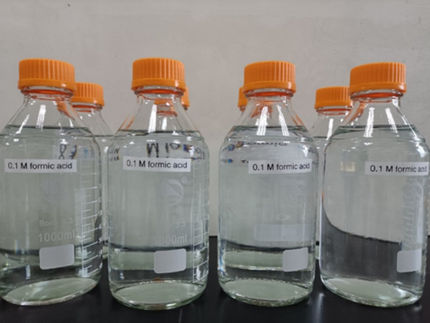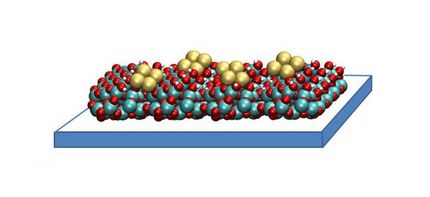New strategy boosting carbon dioxide reduction to carbon monoxide
Classical strong metal-support interaction (SMSI) describes that reducible oxide migrates to the surface metal nanoparticles (NPs) to obtain metal@oxide encapsulation structure during high-temperature H2 thermal treatment, resulting in high selectivity and stability.

New strategy boosting carbon dioxide reduction to carbon monoxide
DICP
However, the encapsulation structure inhibits the adsorption and dissociation of reactant molecular (e.g., H2) over metal, leading to low activity, especially for the hydrogenation reaction.
Recently, a research group led by Prof. LIU Yuefeng from the Dalian Institute of Chemical Physics (DICP) of the Chinese Academy of Sciences (CAS) has proposed a new migration strategy, in which the TiO2 selectively migrates to second oxide support rather than the surface of metal NPs in Ru/(TiOx)MnO catalysts, boosting the CO2 reduction to CO via reverse water-gas shift reaction.
The researchers achieved controlled migration by utilizing the strong interaction between TiO2 and MnO in Ru/(TiOx)MnO catalysts during H2 thermal treatment, and TiO2 spontaneously re-dispersed on the MnO surface, avoiding the formation of TiOx shell on Ru NPs for the ternary catalyst (Ru/TiOx/MnO).
Meanwhile, high-density TiOx/MnO interfaces generated during the process, acting as a highly efficient H transportation channel with low barrier, and resulting in enhanced H-spillover for the migration of activated H species from metal Ru to support for consequent reaction.
The Ru/TiOx/MnO catalyst showed 3.3-fold catalytic activity for CO2 reduction to CO compared with Ru/MnO catalyst. In addition, the Ti/Mn support preparation was not sensitive to the crystalline structure and grain size of TiO2 NPs. Even the mechanical mixing of Ru/TiO2 and Ru/MnOx enhanced the activity.
Moreover, they verified that the synergistic effect of TiO2 and MnO didn't alter the catalytic intrinsic performance, and efficient H transport provided a large number of active sites (hydroxyl groups) for the reaction process.
"Our study provides references for the design of novel selective hydrogenation catalysts via the in-situ creation of oxide-oxide interfaces acting as hydrogen species transport channels," said Prof. LIU.
Original publication
Most read news
Original publication
Organizations
Other news from the department science
These products might interest you

NANOPHOX CS by Sympatec
Particle size analysis in the nano range: Analyzing high concentrations with ease
Reliable results without time-consuming sample preparation

Eclipse by Wyatt Technology
FFF-MALS system for separation and characterization of macromolecules and nanoparticles
The latest and most innovative FFF system designed for highest usability, robustness and data quality

DynaPro Plate Reader III by Wyatt Technology
Screening of biopharmaceuticals and proteins with high-throughput dynamic light scattering (DLS)
Efficiently characterize your sample quality and stability from lead discovery to quality control

Get the chemical industry in your inbox
By submitting this form you agree that LUMITOS AG will send you the newsletter(s) selected above by email. Your data will not be passed on to third parties. Your data will be stored and processed in accordance with our data protection regulations. LUMITOS may contact you by email for the purpose of advertising or market and opinion surveys. You can revoke your consent at any time without giving reasons to LUMITOS AG, Ernst-Augustin-Str. 2, 12489 Berlin, Germany or by e-mail at revoke@lumitos.com with effect for the future. In addition, each email contains a link to unsubscribe from the corresponding newsletter.




























































